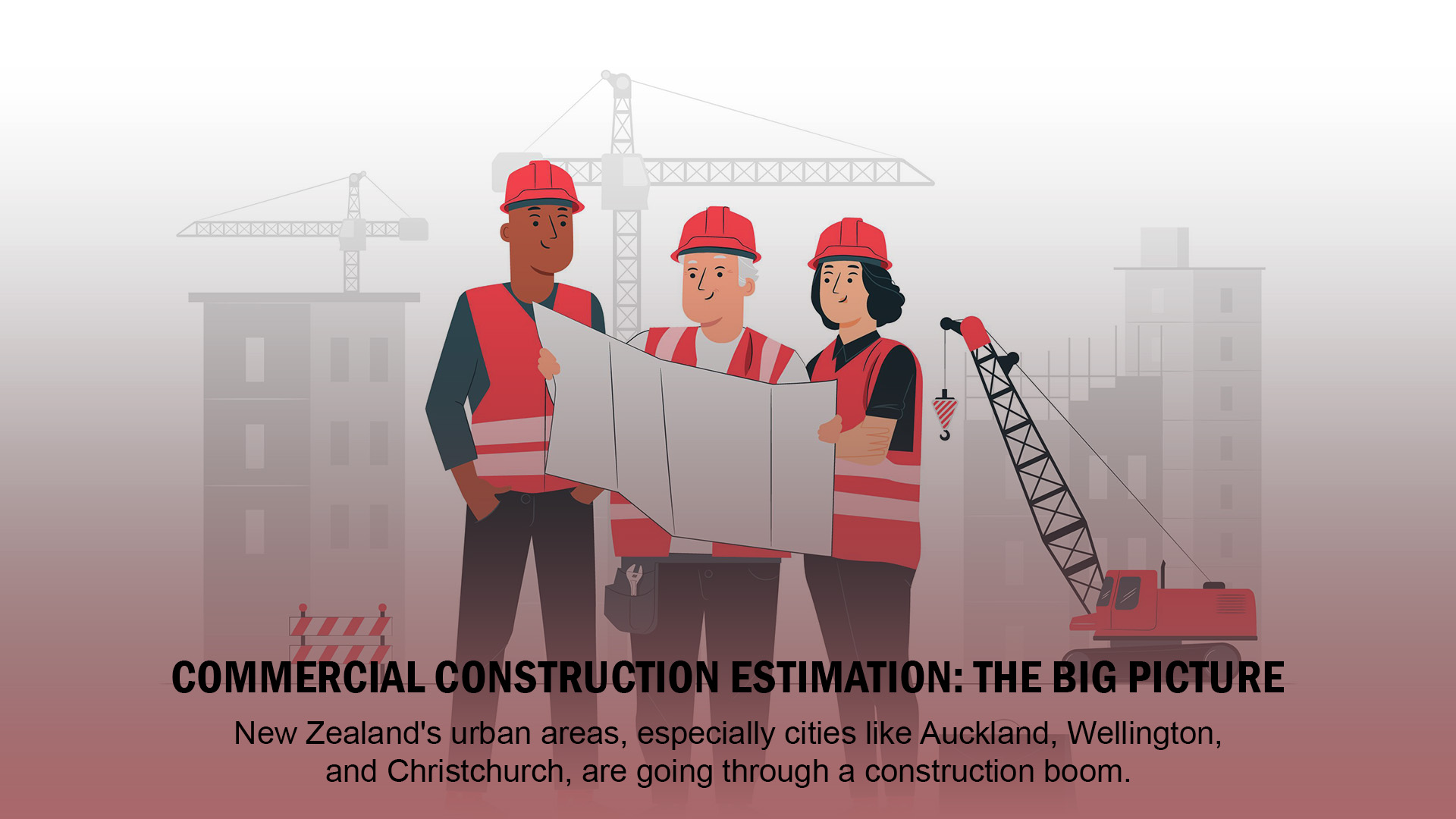Imagine walking through the heart of Auckland on a weekday morning. Cranes dot the skyline like metallic giraffes, glass towers rise higher with every passing week, and the hum of heavy machinery becomes part of the city’s rhythm. This isn’t just construction; it’s transformation.
New Zealand’s urban areas, especially cities like Auckland, Wellington, and Christchurch, are going through a construction boom. Office buildings, malls, hotels, hospitals, and mixed-use complexes are springing up to keep pace with the country’s growing population and evolving business landscape. Behind this progress, however, is a complex, meticulous, and often underestimated process: commercial construction estimation.
In this article, we’re going to strip away the complexity and explore the big picture of commercial construction estimation in New Zealand what it is, why it matters, how it works, and why cost overruns keep happening despite all the planning. Let’s step into the story behind the steel.

What Is Commercial Construction Estimation?
Let’s keep it simple. Commercial construction estimation is the process of forecasting how much money a commercial building project will cost. This includes everything: design, labour, materials, equipment, permits, site prep, and even the coffee in the site office.
Think of it like making a shopping list for a huge dinner party except that party lasts 18-36 months, needs hundreds of people, and one missing item could cost you millions.
Why Estimation Is So Important
In commercial projects, especially in urban centres, everything is bigger:
- Bigger budgets
- Bigger teams
- Bigger timelines
- Bigger risks
So getting the numbers right at the beginning is everything. One small error in the estimating phase can cause a domino effect across the whole project. That’s why developers, builders, investors, and city councils rely heavily on accurate, professional estimates before anyone breaks ground.
Breaking Down the Costs in Urban Construction
Now let’s look at what goes into the cost of a large-scale commercial build.
1. Land and Site Preparation
Urban land doesn’t come cheap. Even before construction begins, there’s a lot to consider:
- Land acquisition costs
- Demolition of existing structures
- Earthworks and ground stability
- Environmental assessments
- Utilities setup (water, power, sewage)
2. Design and Professional Fees
Before a single nail is hammered, architects, engineers, planners, and surveyors must be paid:
- Architectural design fees
- Structural, mechanical, and electrical engineering
- Project management fees
- Building consent applications
3. Materials
In commercial projects, you’re not just buying bricks and timber:
- Structural steel
- Concrete slabs and precast panels
- HVAC systems
- Glazing and cladding
- Fire systems, insulation, and smart tech
Prices can fluctuate wildly depending on international supply chains, fuel costs, and even global events like pandemics or wars.
4. Labour
Construction labour in New Zealand is in high demand and often in short supply:
- Site managers
- Carpenters, plumbers, electricians
- Crane operators and heavy machinery drivers
- Health and safety officers
Labour laws, union agreements, and weather delays also impact costs.
5. Compliance and Permits
You can’t build a skyscraper in Auckland without jumping through a few hoops:
- Resource consent
- Building code compliance
- Fire safety, accessibility, and seismic standards
6. Unexpected Costs and Contingency
No matter how perfect your plan is, surprises happen:
- Delays due to bad weather
- Material shortages
- Design changes mid-project
- Contractor disputes
That’s why smart estimators always include a 10-20% contingency buffer.
Also Read: Top Home Renovation Trends in Australia and New Zealand for 2025
A True Story: The Budget That Kept Slipping
Let’s travel back a few years to a real case in Christchurch. After the devastating 2011 earthquake, there was a rush to rebuild the city’s commercial centre. One high-profile project a major hotel chain’s flagship property started with a \$55 million budget.
As months passed, the budget crept up: \$58 million, then \$62 million, and finally close to \$70 million by completion. Why?
- Structural changes due to updated earthquake standards
- Difficulty sourcing skilled labour locally
- Increased material costs due to global shortages
- Delays in council approval
This wasn’t a mismanaged project. It was just reality. And it highlighted the importance of thorough, forward-thinking estimation.
Why Cost Overruns Are So Common in NZ
You might be wondering: if estimation is so critical, why do cost overruns keep happening in New Zealand’s commercial construction sector?
Here are the big reasons:
1. Booming Demand Outpaces Supply
New Zealand’s commercial sector is growing fast, but the supply of materials and skilled labour isn’t keeping up. This creates shortages and drives up prices.
2. Unpredictable Global Markets
So many construction materials are imported. If there’s a delay at an overseas port or a surge in global steel prices, local budgets get hit.
3. Changing Regulations
In an era of climate change, health risks, and earthquake awareness, the rules keep evolving. Builders have to adapt to new codes, which usually means higher costs.
4. Urban Constraints
Building in cities is tough:
- Limited space for storage
- Restricted access for large vehicles
- Noise and disruption constraints
- Heritage buildings that can’t be touched
All of these add time and money to a project.
5. Client-Driven Changes
Clients often change their minds midway:
- Wanting higher-end finishes
- Adding new features like rooftop gardens or electric vehicle stations
- Requesting design changes after seeing early results
These changes throw estimates off balance.
The Role of the Estimator
In this chaotic environment, the estimator becomes the unsung hero. Their job isn’t just about math; it’s about strategy, foresight, and risk management.
They:
- Study historical cost data
- Research suppliers and labour rates
- Understand regulatory requirements
- Communicate with architects and engineers
- Run “what if” scenarios
Great estimators don’t just count the costs they anticipate them.
New Zealand’s Estimation Tech Evolution
Thankfully, the days of scribbling figures on a clipboard are long gone. Kiwi construction firms are embracing digital tools to stay ahead.
1. Estimating Software
Tools like CostX, Buildsoft, and Cubit allow estimators to:
- Create detailed quantity takeoffs
- Adjust for regional rates
- Integrate with BIM (Building Information Modelling)
2. Drones and Scanning Tech
Site surveys are faster and more accurate thanks to drone mapping and 3D laser scanning.
3. AI and Predictive Modelling
Some large firms are experimenting with AI tools that predict cost risks based on thousands of past projects.
It’s not just innovation for the sake of it it’s a response to a market that demands precision.
A Glimpse Into the Future
So, what does the future hold for commercial construction estimation in New Zealand?
1. Sustainable Construction Will Change Costs
With the push for greener buildings, materials like cross-laminated timber, solar panels, and recycled steel are becoming common. These change the cost structure dramatically.
2. Prefab and Modular Construction
As time becomes money, more developers will turn to off-site construction. This means estimators will need to adapt their methods to include transportation, craneage, and factory production costs.
3. Greater Collaboration from Day One
In the future, estimation won’t be a one-time task at the start. It will be an ongoing, collaborative process involving everyone from architects to tradies, using shared digital platforms.
Final Thoughts: Building Smarter, Not Just Bigger
In the world of commercial construction, cities don’t just grow they evolve. And at the core of this evolution is the ability to plan financially and practically for what lies ahead.
Estimation isn’t about guessing it’s about envisioning. It’s not just a spreadsheet it’s a story of how raw land becomes a living, breathing building.
And in New Zealand, where commercial construction is both an opportunity and a challenge, accurate estimation is the silent foundation under every towering structure.
So next time you see a crane cutting through the city skyline, remember: before it lifted steel beams, someone had to lift a pen and imagine the cost of every bolt, brick, and beam. That’s the big picture of commercial construction estimation.
